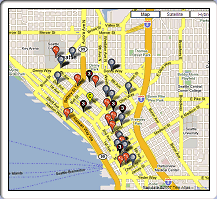Introduction
As 10 Gigabit Ethernet (10GbE) is introduced into networks the physical limitations and properties of optical fiber introduce new challenges for a network designer. Due to the increased data rate, fiber effects, such as dispersion (intermodal, chromatic or polarization), become a factor in the achievable distances of 10GbE links. This leaves the network designer with new decisions and trade-offs that he/she must understand and overcome.This paper provides an introduction to the world of optical fiber and covers the unique network design issues that 10GbE introduces into an optical fiber network.
Fiber 101
There are two different types of optical fiber: multimode and single-mode. Both are used in a broad range of telecommunications and data networking applications. These fiber types have dominated the commercial fiber market since the 1970’s. The distinguishing difference, and the basis for the naming of the fibers, is in the number of modes allowed to propagate in the core of a fiber. A “mode” is an allowable path for the light to travel down a fiber. A multimode fiber allows many light propagation paths, while a single-mode fiber allows only one light path.
In multimode fiber, the time it takes for light to travel through a fiber is different for each mode resulting in a spreading of the pulse at the output of the fiber referred to as intermodal dispersion. The difference in the time delay between the modes is called Differential Mode Delay (DMD). Intermodal dispersion limits multimode fiber bandwidth. This is significant because a fiber’s bandwidth determines its information carrying capacity, i.e., how far a transmission system can operate at a specified bit error rate.
The optical fiber guides the light launched into the fiber core (Figure 1). The cladding is a layer of material that surrounds the core. The cladding is designed so that the light launched into the core is contained in the core. When the light launched into the core strikes the cladding, the light is reflected from the core-to-cladding interface. The condition of total internal reflection (when all of the light launched into the core remains in the core) is a function of both the angle at which the light strikes the core-to-cladding interface and the index of refraction of the materials. The index of refraction (n) is a dimensionless number that characterizes the speed of light in a specific media relative to the speed of light in a vacuum. To confine light within the core of an optical fiber, the index of refraction for the cladding (n1) must be less than the index of refraction for the core (n2).

Fibers are classified in part by their core and cladding dimensions. Single-mode fibers have a much smaller core diameter than multimode fibers. However, the Mode Field Diameter (MFD) rather than the core diameter is used in single-mode fiber specifications. The MFD describes the distribution of the optical power in the fiber by providing an “equivalent” diameter, sometimes referred to as the spot size. The MFD is always larger than the core diameter with nominal values ranging between 8-10 microns, while single-mode fiber core diameters are approximately 8 microns or less. Unlike single-mode fiber, multimode fiber is usually referred to by its core and cladding diameters. For example, fiber with a core of 62.5 microns and a cladding diameter of 125 microns is referred to as a 62.5/125 micron fiber. Popular multimode product offerings have core diameters of 50 microns or 62.5 microns with a cladding diameter of 125 microns. Single-mode fibers also have125 micron cladding diameters.
A single-mode fiber, having a single propagation mode and therefore no intermodal dispersion, has higher bandwidth than multimode fiber. This allows for higher data rates over much longer distances than achievable with multimode fiber. Consequently, long haul telecommunications applications only use single-mode fiber, and it is deployed in nearly all metropolitan and regional configurations. Long distance carriers, local Bells, and government agencies transmit traffic over single-mode fiber laid beneath city streets, under rural cornfields, and strung from telephone poles. Although single-mode fiber has higher bandwidth, multimode fiber supports high data rates at short distances. The smaller core diameter of single-mode fiber also increases the difficulty in coupling sufficient optical power into the fiber. Relaxed tolerances on optical coupling requirements afforded by multimode fiber enable the use of transmitter packaging tolerances that are less precise, thereby allowing lower cost transceivers or lasers. As a result, multimode fiber has dominated in shorter distance and cost sensitive LAN applications.
Optical Fiber Standardization
A number of domestic and international organizations are involved in management of the optical and mechanical parameters of optical fiber in both bare and cabled form, as well as their subsequent application. The common charter of all of these organizations can be distilled into a few salient points. By introducing standardized bounds on the optical parameters of transmission fibers (e.g., modal dispersion, attenuation, cutoff wavelength), system vendors and customers alike can be assured of reasonable degrees of infrastructure capability and consistency, while fiber manufacturers have reasonable flexibility for product improvement and new product development. The broader missions of certification assistance and promotion of international trade apply as well.
Outside of cabling and mechanical specifications, which are equally addressed in the standards, the primary optical specifications are modal bandwidth and attenuation (for multimode fiber), and attenuation, chromatic dispersion, and cutoff wavelength for single-mode fiber. See the glossary for a definition of these terms.
The standards bodies with vested interest in the governance of optical fiber specifications are:
- ISO (International Organization for Standardization) – ISO comprises national member bodies which are “most representative of standardization in its country”, representing over 90 nations. For optical fiber specifications and standards, ISO and IEC collaborate on several Joint Technical Committees (JTC).
- IEC (International Electrotechnical Commission) – IEC addresses the electronics and telecommunications industries, and counts over 50 nations among its membership. The current IEEE 802.3 standard for 10 Gigabit Ethernet cites ISO/IEC standard 11801 for optical fiber specification compliance, which in turn refers to IEC 60793-2 for detailed optical fiber parameter requirements.
- TIA (Telecommunications Industry Association) – TIA operates under the umbrella of the Electronic Industries Alliance (EIA), and focuses its efforts on the telecommunications and information technology industries. TIA was initially formed as a consortium of suppliers to the United States independent telephone industry, but has since broadened its technical scope and has adopted a more global perspective. TIA is commonly cited (typically in conjunction with the American National Standards Institute or ANSI) for optical fiber and system test procedures.
- ITU (International Telecommunication Union) – The ITU falls under the auspices of the United Nations System of Organizations, and comprises (like the ISO) a large number of sovereign nations as its membership. Over 180 countries currently are represented within the ITU. The ITU administers the commonly referenced single-mode fiber standards documents, G.652 through G.655, as cited by optical telecommunications systems providers and their customers.
This is page 1 of 4 of the whitepaper “Optical Fiber and 10 Gigabit Ethernet”. Continue to next page
Links of interest:
- Ethernet Whitepapers
- USA Business & Carrier Metro Ethernet
- Metro Wave Division Multiplexing, DWDM Services and DWDM/ROADM
- Business Phone Systems (external)
- International WAN & DIA Services
- Wholesale SIP Termination (carrier & enterprise)
If you found this page helpful, please support us linking to this page.
- fiber optic vs ethernet
- fiber to ethernet
- optical fiber
- single mode bandwidth
- 10 gigabit ethernet multimode fiber
- optical fiber specifications
- multimode Fiber specifications
- old fiber 10 gb ethernet
- Optical Fiber Core
- wiki fibre micron
Related posts:

